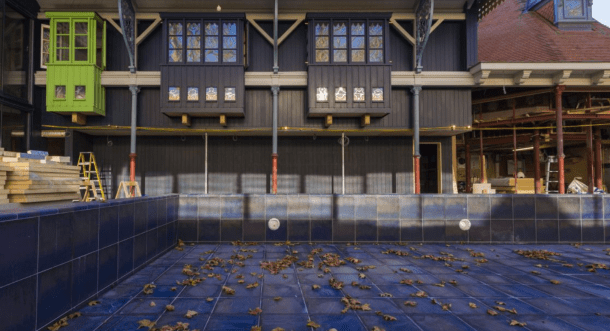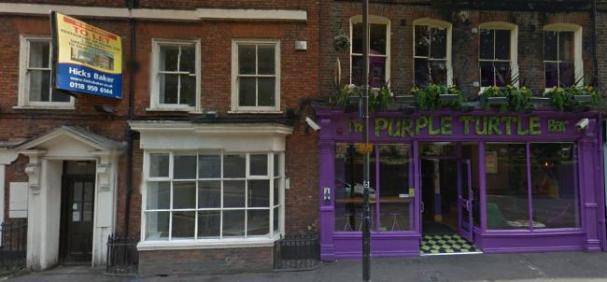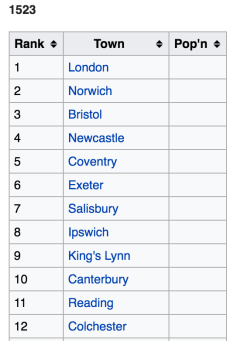
A year ago I set out half a dozen hopes and expectations for 2016. I think we’ve managed three out of six. Let’s take a look at what’s been ticked off, and throw in a few extra things to look out for in 2017.
2016’s successes
1) The Biscuit Tin and events space at Station Hill
Opened in June, the Biscuit Tin and adjacent event space sits on the plot that will become the final Station Hill office building when the scheme completes in around ten years time. The venue has made a good start and often looks busy. The event space was home to a big screen for the Euros, and a great Apres ski-themed bar throughout December. For my tastes, the Beach concept in the summer was less successful with the fairground element being too brash and noisy. Hopefully future events might better integrate the Biscuit Tin cafe itself and use the full event space area.
2) Double demolition
As expected, we finally saw the back of much-disliked Kings Point, and the old civic centre. The former will be redeveloped as apartments straightaway, whilst we still await plans for the civic. I’d hope those proposals will be revealed in 2017, alongside plans for a significant refurbishment/expansion of the Broad Street Mall around Queen’s Walk.
3) Simond’s Bank brought back into use
Well, almost. The builders finally began on site in Kings Street in December. Hopefully they won’t have been set back too much by a recent fire, reported by GetReading. ‘The Botanist’ is the chain that will occupy the refurbished unit, and let’s hope it retains some character of the historic bank.
Although not listed in my piece a year ago, I must mention the 2016 year of culture initiatives. We had the prison exhibition, a play about Henry I, the fabulous Light Up Reading, and many more events besides.
2017’s resolutions
1) Thames Lido
The Kings Meadow Baths are to re-open in the spring as the Thames Lido. Judging by the latest photos of the project, it’s going to be absolutely fantastic. I can’t wait to visit and see for myself the fruits of their painstaking restoration, as well as sample the food that’s widely acclaimed at the owner’s Bristol equivalent. I think we’ve got lucky with this scheme, so expect to hear a lot about the Thames Lido next year.

2) High hopes for high ropes
This is some positive news on leisure from the council, following a difficult period where they disappointingly felt they had to close Arthur Hill pool years before building its replacement. The Rivermead driving range is to close and the site used for an activity centre including high ropes, mini golf and archery. This could be a fun-filled family destination at weekends, and used by schools in the week. I hope that it’s highly visible and accessible from the Thames path.
Along with the lido, Reading is building a ribbon of leisure along its stretch of the Thames. In 2017 we could go further by reviving plans to use the riverside corner of Hills Meadow car park for the mooted Hexagon replacement, and by incorporating a significant leisure element in redevelopment proposals for the SSE site at the southern landing of the Christchurch bridge, with the utilities provider moving to Forbury Place in the coming months. Could 2017 be the year that Reading finally grabs hold of its enviable position on one of the world’s most famous rivers?

3) Purple Turtle’s next door neighbour
The Chronicle has reported that the new year will see building work begin on Gun Street. The back garden of the vacant property next to the Turtle will be excavated to create a basement extension to the popular bar. The main part of the building will then become a stand-alone cafe/restaurant with a garden terrace alongside an uncovered stretch of the Holy Brook. I really like this corner of town, and these look to be exciting plans.

4) Third Thames Bridge progress
Carried over from 2016. I think the summary is “moving slowly in the right direction”. My write-up in the summer was my third most read piece this year, and we still await the outcome of that traffic modelling study. It appears our fate rests with a computer simulation named SATURN. I find it a somewhat ironic title for modelling the traffic woes of one of the country’s largest inland towns or cities with no Outer Ring. I’d hoped for an outcome this year, but a lap of the sun for Saturn equates to 29 Earth years so perhaps I should have been more explicit. We’re eagerly awaiting Rob Wilson’s next update, which might hopefully point towards submitting a bid for government funding within the next twelve (Earth) months.
5) Finally, Reading Gaol
Whilst the third bridge is undoubtedly Reading’s top economic priority, the prison is our number one cultural opportunity. Despite closing in 2013, there are still no firm plans. The ministry of justice intends to sell it and their bean counters want to maximise their return. A “development brief” needs to be written to accompany the sale. The nearer that document paraphrases to “flats allowed” the more money they’ll make. The government also has a policy headline about converting outdated jails into housing. This is probably making our MPs lives trickier, but come on, we have a zillion flats in the pipeline.

In my view, the prison would be the perfect anchor for Reading’s historic area, now being termed “The Abbey Quarter” by the council in a laudable attempt to celebrate our rich local history.
This site should become the must-visit school trip destination for all children in our area to learn about Reading’s past, the Abbey, Henry I, Oscar Wilde etc. Wouldn’t it be great to have a small theatre there, perhaps like ‘The Egg’ in Bath aimed at children?
I could see other parts become a hotel, with restaurants and cafes on the ground floor overlooking the ruins. Some housing on the footprint of the more recent prison extensions could be supported.
I’d like to see all our local MPs join forces to prevent a drab apartment conversion. Rob Wilson is carrying the fight, and I know it’s his constituency but I think it’s really important for the whole area to have a thriving, distinctive, historic epicentre around which Reading can build its identity. We should take no prisoners in the battle to save the gaol.
This is what happened when Oxford’s prison closed:
The prison was closed in 1996 and the site reverted to Oxfordshire County Council. The Oxford Prison buildings have since been redeveloped as a restaurant and heritage complex, with guided tours of the historic buildings and open courtyards for markets and theatrical performances. The complex includes a hotel in the Malmaison chain, Malmaison Oxford, occupying a large part of the former prison blocks, with cells converted as guest rooms… The mixed-use heritage project, officially opened on 5 May 2006, won the RICS Project of the Year Award 2007.
There’s your development brief. Let’s hope to see something along those lines when it’s published by the end of 2017.
Thank you to everyone for reading my ramblings throughout 2016, and particularly those who’ve taken the time to comment either directly here, on twitter, facebook or the Reading Forum. Happy New Year to you all!
Follow @readingonthames
Note, comments welcome and can be left without any registration!
[…] A look ahead to Reading’s 2017 […]
LikeLike
Another thing going on in 2017 is the celebration of the 70th anniversary of Reading’s friendship with Düsseldorf. There will be music (from classical to rock). There will be art and performance. There will be exhibitions. There will be sport. And it’s all about remembering how Reading continued the fight against Nazism by affirming our common humanity with people in Germany, helping them when they needed it – and about affirming our common humanity now, by making friends and continuing friendship.
More at http://www.reading-dusseldorf.org.uk as details emerge.
LikeLike
Thanks Robert. Sounds excellent
LikeLike
I really like your ideal of the jail becoming Reading’s most important ‘cultural opportunity’! It is important that planners do consider the historical aspect of this – I know having enough houses is crucial, but preserving places of cultural and historic importance is also so important not just for our own time, but for future generations.
LikeLiked by 1 person
[…] I’d also like to see progress on the third bridge. This wish is carried over from my 2017 list. Sadly, I don’t expect to see any traffic carried over a new Thames bridge for a little […]
LikeLike